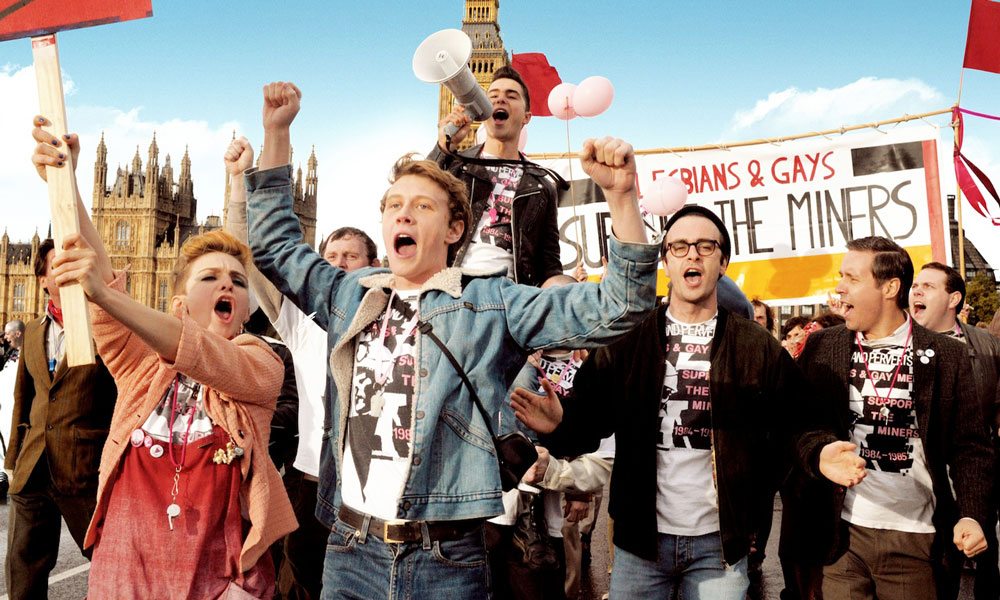In the last 50 years, queer cinema in Britain has come a long way.
When the British parliament passed the Sexual Offenses Act of 1967 — which stated that: “a homosexual act in private shall not be an offense provided that the parties consent thereto and have attained the age of 21 years” — it sought to legitimate gay identity in Britain, at least partially. Interestingly, the language contained within — the “homosexual act in private” — speaks directly to gay experience.
First, the document’s phrasing connotes ideas around “acting”, “performing”, “presenting” oneself in a particular way (the theatre has long been a bastion for queer creativity) and, second, the dichotomy of public and private space, where people can “be themselves”. The Act seems to be constructing a social stage (albeit obscured, out of view) on which gay men can perform. For a man living in Britain before 1967, to be gay was a criminal offense. Therefore, how and where he was able to perform his homosexual identity would have been a constant source of anxiety and danger.
It should be mentioned that the Sexual Offenses Act did not legislate for the decriminalization of female homosexuality. This could stem from Queen Victoria’s apparent belief that lesbians didn’t even exist — or a more troubling reflection on the view of women generally in the British social sphere at the turn of the 20th century. However, lesbians do feature throughout the course of this 50-year history and should be included within these debates around increased visibility — even if, when compared with films about gay male experience, they are underrepresented.
Related | How the Nazis Destroyed the First Gay Rights Movement
It’s fair to say that 1967 and the years after the Act was passed did not open the floodgates for the immediate visibility of gay lives. Neither should the pre-1967 years be considered as a cinematic wasteland with no queer inhabitants. Rather, ways of viewing such characters in these films and the ways in which they were represented changed. As Andy Medhurst explains in his entertaining and thoughtful search for “nebulous nancies” in British films made between the 1940s and 1960s, the aim of the queer spectator was to pick up on visual and verbal clues which would give away a character’s or actor’s “gayness”.
These could be a costume, a glance, a sibilant delivery of a line, but would form a viewer’s set of identifiers, both a visual and verbal vocabulary of how to identify themselves in characters on the big screen. For Medhurst, films such as Once a Jolly Swagman (1948), Mr Perrin and Mr Traill (1948), and High Treason (1951) all offer up clues for a spectator who is “in the know”. As soon as Michael Ward’s character gushes “Tony can be deliciously devastating” at a cocktail party in Swagman, we understand exactly what he means and who he is.
Nevertheless, in Britain during this time any overt gay characters were often marginalized or non-existent. It was not until the 1950s and the high-profile trials involving Lord Montagu, Michael Pitt-Rivers, and Peter Wildeblood for homosexuality that the issue received substantial social attention. As a result, in 1957, Lord John Wolfenden and his committee published their report which had investigated “homosexuality and its implications for British social life and the law”.
Related | How Gay Sex Was Decriminalized in Britain
The Wolfenden report proved an influential precursor to the 1967 Act. The findings proved highly divisive among the British public, as did the subsequent release of films which capitalized on the scandals that rocked the upper classes. Even so, this political conversation about homosexuality was still reflected in film at the time in hushed tones.
On the small screen, South, based on the play by Julien Green and shown as part of ITV’s Play of the Week series in 1959, is the earliest surviving British gay television drama. Set against the backdrop of the American Civil War, it depicts the tortuous realization of soldier Jan Wicziewsky (played with brio and bluster by Peter Wyngarde) that he desires another man who visits the plantation house at which he is staying. As was common with so many gay stories, Jan is doomed to die, unable to profess his love and killed in a duel by the object of his affections. Coded conversations and meaningful looks indicate that South was made at a time when queer love still dare not speak its name.
Victim (1961) was a film which dared to speak louder and more directly about gay experience. It starred matinee idol Dirk Bogarde as a closeted gay lawyer who is implicated in a blackmail ring which threatens to expose his gay identity and destroy his career. As well as situating its gay politics within a thriller narrative designed to appeal to a wider audience, it is noteworthy for being one of the first British films to cast a well-known actor in a gay title role.
Extra-textual elements about Bogarde’s own private life as a gay man lend the film and his performance in it additional meaning and an authenticity which inflects his performances in later films such as Joseph Losey’s The Servant (1963) and Darling (1965). Victim would mark a career-long fascination with Bogarde’s queer star persona and his own, often reluctant, negotiation of a gay identity.
John Schlesinger, who directed Bogarde in Darling, was one of a group of gay filmmakers working during the “Swinging 60s”, within an atmosphere of sexual freedom. Schlesinger, with Tony Richardson and Lindsay Anderson, emerged out of the Free Cinema movement in the 1950s. This was a cinema which, often through documentaries, reacted against the perceived privilege of British filmmakers and tended to focus on a disenfranchised individual, the prototypical “angry young man”.
In films as diverse as The Loneliness of the Long Distance Runner (Richardson, 1962), This Sporting Life (Anderson, 1963), If… (Anderson, 1968), and Sunday Bloody Sunday (Schlesinger, 1971), we see male central characters who — as UK film academic Robin Griffiths wrote in his history of Queer Cinema, “find themselves trapped, symbolically reflect[ing] both the experiences of their respective directors, and the general dilemma of being queer in British society at the time”. Regardless of whether or not they were explicitly described as being gay, these tragic figures presented the plight of gay men who were desperately searching for somewhere to “be themselves”.
Stigma signals
It is precisely this notion of performance which captures the quandary for gay men living in a society where being homosexual is synonymous with being “unnatural”. Canadian-American sociologist Erving Goffman, writing in 1968 (a year after the Sexual Offenses Act was passed in England and Wales), includes homosexuality as a social stigma — that is, a marker which disqualifies an individual from full social acceptance. He continues by describing evidence of stigma as “reflexive and embodied” and so communicated by the person through bodily expression via “stigma symbols”.
For the gay man, these could range from (self-evident) sexual relations with someone of the same sex to less obvious symbols which have developed in society and culture over time — for example drag queens, effeminate behavior and particular ways of dressing or acting. In the interest of self-preservation, an individual may want to conceal their stigma symbol(s), which means that visibility is important for someone who is stigmatized.
Related | How Families With Two Dads Raise Their Kids
It is significant, then, that in some of the films released in Britain in the immediate years after the Sexual Offenses Act was passed, performance figures so centrally to the stories; in the characterizations of the actors and critical reactions to them. Staircase (Stanley Donen, 1969), featuring Richard Burton and Rex Harrison as a couple of “flaming queen” hairdressers, drew the critical ire of Roger Ebert (and, one imagines, some of the gay community) for their portrayal of Harry and Charlie as a parodic “sideshow attraction”. Ebert comments further that we’re “not asked to watch a movie about homosexuals, but a movie about Harrison and Burton playing homosexuals”.
Consider also Nic Roeg’s Performance (1970) — whose performative agenda is writ large from the title — and its gender fluid boundaries that constitute the film’s plot, gently subverting the British gangster genre. Later came The Crying Game (1992) whose “big reveal” demonstrates the permeability of gender categories played out within a neo-noir story where, for Richard Dyer, the genre’s themes of uncertainty, mystery, and duplicity in the search for a cold-hearted killer become a question of “who is queer?” As such, these films all highlight the significance of looking a certain way, which for the queer spectator prior to the 1967 Act entailed looking for queer characters.
Another way of looking
This act of looking, this voyeurism, is closely linked to the cinematic apparatus and forms the titles of numerous British queer films in this period. Whether one is Looking for Langston (1989) — the title of Julien’s 1989 film about gay black American poet Langston Hughes — or Caught Looking (1991) — Constantine Giannaris’ 1991 film aboutrisqué fantasies — the desire to see and be seen has been crucial in the advancement of gay rights.
In 1978, Nighthawks — another attention-grabbing film title — took spectators into the subterranean milieu of gay clubs. Presumably taking its title from the famous Hopper painting, Ron Peck’s film is widely heralded as the first gay movie produced and commercially released in Britain. It follows Jim, a teacher by day and a cruiser by night, who is eager to make a romantic connection with the men he picks up.
Peck’s direction and Paul Hallam’s writing gives the film an authenticity of gay experience in 1970s London and focuses on the importance of “looking” — looking a certain way or looking for your next hook-up. Nighthawks offers a glimpse into one man’s negotiation of identity and would go on to influence future British gay filmmakers such as Andrew Haigh and his films Greek Pete (2009) and Weekend (2011).
Touch of class
British film has historically had a singular fascination for social dramas centered on class. In Thatcher-era Britain, debates around class, race and sexuality were heated and found their way into films of the period. Entries into this queer canon of British films included Merchant and Ivory’s lavish adaptation of E.M. Forster’s posthumously-published, semi-autobiographical novel Maurice (1987) and the Hanif Kureishi-scripted My Beautiful Laundrette (Stephen Frears, 1985).
Both films spoke to a contemporary social context which, through an increasing sense of British nationalism, created groups of outsiders based around racism and homophobia. It is telling, then, that against this decidedly bleak cultural backdrop these two films offer something of the utopian in their representations of university society Edwardian England and an aspirational Pakistani in 1980s London respectively — “an English Arcadia” as Michael Williams puts it. Equally suggestive however may be “utopia’s” double meaning of “ideal place” and “no place”. The fight for visibility, acceptance — and a place to call home within British society and cinema continues.
Related | Who’s Avoiding Sex, and Why
During the 1980s and 1990s, a group of gay British filmmakers emerged and were subsequently adopted into the “New Queer Cinema” movement inaugurated in North America. Each had a recognizable style which developed through “personal is political” narratives and arthouse aesthetics.
Isaac Julien (Looking for Langston, Young Soul Rebels [1991]) became the voice of a black gay identity. Meanwhile, Terence Davies would tackle elements of his own homosexual awakening within a repressive Catholic upbringing and a dysfunctional family unit in his films The Terence Davies Trilogy (1983), Distant Voices, Still Lives (1988) and The Long Day Closes (1992). These films of intense feeling are metaphysical looks inward by Davies which reveal the fluidity of memory used to construct a gay “self”.
Queering history
One of the most critically acclaimed queer voices in British cinema at this time was Derek Jarman. Films such as Sebastiane (co-directed with Paul Humfress, 1976) and The Angelic Conversation (1985) demonstrated Jarman’s experimental aesthetic and sensual imagery which privileged the “look” of his films.
Dyer proposes that the significance of the “look” of these films, and perhaps why so much invigorating queer film-making was being done independently and shown in underground venues (as well as for commercial reasons), was a reflection of the “surface” homosexuals had to manage in order to pass for heterosexual. But Jarman’s films also reveal another, more subversive, move which was a feature of British gay film — the “queer biopic”.
Perhaps Jarman’s best-known films (if it is possible to talk of such) are his biographical treatments of notable cultural figures. Caravaggio (1986), Edward II (1991) and Wittgenstein (1993) can be interpreted as a “queering” of history, to emphasize the sexuality of their respective central figures in order to carve a space for gay visibility within the largely heterosexual (not to mention, white and male) academy.
Understandably, British film has had a long held fascination for the camp celebrity of Oscar Wilde (which continued with Stephen Fry’s Wilde [1997]), but other, less ubiquitous, gay lives are documented. Playwright Joe Orton (very much the theatrical descendant of Wilde’s risqué high society satire) is memorably portrayed by Gary Oldman in Prick Up Your Ears (1987), Ian McKellen plays Frankenstein director James Whale in Gods and Monsters (1998) and, in The Imitation Game (2014), Benedict Cumberbatch’s Alan Turing races to crack the enigma code during World War II as he wrestles with his homosexuality.
Out in the mainstream
Mainstream appeal may or may not be the aim of these queer films — but social, cultural and legal acceptance would surely be the hope of their gay audiences. There has been a small, yet noticeable, shift towards increased gay representation in British feature films. In films such as The Best Exotic Marigold Hotel (2011) and Philomena (2013), queers occupy sub-plots, but Pride (2014) puts its subject matter (equal rights for lesbians, gay men and Welsh miners in 1984’s strikes) front and centre. The film’s comedy genre-leanings and all-star British cast ensured healthy takings at the UK box office.
Additionally in British-American big budget co-productions, gay characters are beginning to find a place. Disney’s live-action remake of Beauty and the Beast (2016) featured a (very) brief scene of a supporting male character dancing with another man, and the crew of horror sequel Alien: Covenant (2017) included a gay couple — and, later, Michael Fassbender’s cyborg locking lips with “himself”). These two examples prompted backlash in conservative countries and indicate that there is still work to be done for gays to find acceptance on the big-screen.
With this is mind, when someone comes to write an article in 2067 to mark the Act’s centenary, let’s hope that all LGBTQ+ people can come out from a cinema screen and into a British social context in which being prosecuted and persecuted for simply loving someone is a distant memory.
Adam Vaughan is a Postgraduate Researcher at the University of Southampton
This article was originally published on The Conversation. Read the original article.







